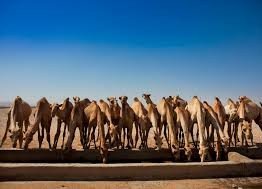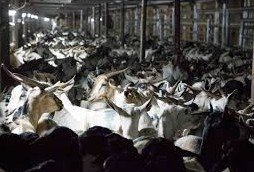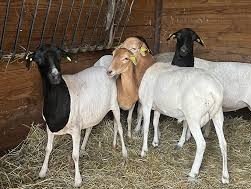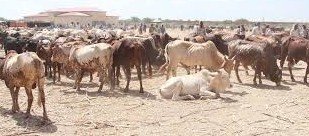Somalia, situated in the Horn of Africa, is a country with a predominantly pastoral economy, where livestock farming has historically been and continues to be a crucial element of social and economic life. Livestock in Somalia: The Backbone of the Economy With its arid and semi-arid landscapes, Somalia provides a suitable environment for various livestock species, particularly camels, goats, and sheep. Livestock is the backbone of the Somali economy, contributing substantially to the livelihoods of nearly 60% of the population and comprising about 40% of the country’s Gross Domestic Product (GDP). https:-botanguide-com-livestock-in-somalia The following sections delve deeper into the significance, diversity, challenges, and potential of the livestock sector in Somalia. Livestock in Somalia: The Backbone of the Economy
Economic Contribution of Livestock Livestock in Somalia: The Backbone of the Economy
Livestock Production and Export
The livestock sector is vital to Somalia’s economy, serving as a source of food, income, and employment. Livestock such as camels, goats, sheep, and cattle are raised for various purposes, including milk production, meat supply, and hide and skin exports. The industry also has a sizable export market, particularly for goats and camels, which are highly sought after in the Middle East, especially in countries like Saudi Arabia, the United Arab Emirates, and Oman.
Livestock exports significantly contribute to Somalia’s foreign exchange earnings, providing critical financial resources for the country. In recent years, Somalia has emerged as one of the largest exporters of livestock in the region, especially during the Hajj season when many Muslims seek to purchase animals for Eid al-Adha.
Employment and Livelihoods Livestock in Somalia: The Backbone of the Economy 2025
Beyond economic metrics, livestock is central to the livelihoods of rural Somali communities. Pastoralists and agro-pastoralists rely on their herds for sustenance and economic stability. Each livestock animal often represents wealth, and many families depend on their herds for daily food, income, and cultural practices. The sale of livestock not only provides cash for family needs but also funds essential services such as healthcare and education.
Labor in the livestock sector also extends beyond herding, providing employment opportunities in processing, transportation, and trade. Markets in semi-urban areas serve as vital hubs for livestock trading, creating job opportunities for traders, butchers, and secondary producers.
Cultural Significance of Livestock
Symbol of Wealth and Status
Livestock is deeply embedded in Somali culture, symbolizing wealth, social status, and identity. For many pastoralist communities, the quantity and quality of livestock owned are direct reflections of social standing. Cattle, camels, and goats are often considered forms of savings and investment, and they are integral to communal and family identity.
Throughout Somali history, livestock has played a role in various cultural practices. Animals are often involved in traditional ceremonies such as weddings, where they are slaughtered as a sign of generosity and hospitality. Such traditions reinforce social bonds and community cohesion.
Dietary Importance
Beyond their social and economic roles, livestock provide essential dietary needs for many Somali families. Milk from camels, goats, and cows is a staple food source, often consumed fresh or fermented. The nutritional richness of these products is vital for sustaining the health of rural families. In arid regions where crops may not thrive, dairy products serve as significant sources of nutrition, especially for children.
Meat consumption, particularly of goats and sheep, is also culturally significant. The meat is revered in traditional dishes and enjoyed during communal gatherings and festivals, contributing to the social fabric of Somali life.
Diversity of Livestock in Somalia
Somalia’s unique climatic conditions have led to the development of diverse livestock breeds adapted to the harsh environment.
Camels

Among all livestock, the camel holds a particularly prominent status in Somalia. Known as the “ships of the desert,” camels are uniquely suited to thrive in arid conditions. They are valued for their multi-purpose utility: providing milk, meat, and transportation. Camel milk is exceptionally nutritious and is often consumed fresh or used in traditional dishes. During periods of drought, camels become especially vital, as they can travel long distances to find water sources.
Goats

Goats are another cornerstone of the Somali livestock economy. Their adaptability to various terrains and resilience in harsh climates make them ideal for pastoralists. Various native goat breeds are appreciated for their meat, milk, and hides. Goat milk is significant in many households, and goat meat is highly sought after, especially during religious holidays.
Sheep

Somali sheep breeds, such as the Somali Black and the Dorper, are known for their quality meat production and resilience to disease. Sheep herding is a common practice in many areas, and the demand for sheep meat remains high, both domestically and for export.
Cattle

While less prevalent in certain regions than camels or goats, cattle farming remains important for specific pastoral communities. Cattle not only provide milk but also serve as draft animals, aiding in plowing fields and transporting goods. Breeds such as the Somali cattle breed are adapted to the local environment and contribute to the livelihood of many families.
Challenges Facing the Livestock Sector
Despite its critical importance, the livestock sector in Somalia faces several significant challenges that undermine its potential.
Drought and Climate Change
One of the most pressing issues for Somali pastoralists is climate change and recurring droughts. With climate patterns becoming increasingly unpredictable, drought has led to severe water shortages and depletion of grazing lands, resulting in livestock deaths. The resilience of pastoralist communities is tested as they transition between regions in search of resources, often leading to conflicts over land and water.
Disease Outbreaks
Livestock health is perpetually threatened by disease outbreaks. Diseases like foot-and-mouth disease and peste des petits ruminants (PPR) can decimate herds, leading to significant economic losses. The lack of veterinary services and resources in rural areas exacerbates the situation, preventing timely diagnosis and treatment of sick animals.
Market Access and Infrastructure
Inadequate infrastructure presents hurdles for pastoralists seeking to market their livestock. Poor road conditions and limited access to formal markets restrict traders’ ability to transport livestock and obtain fair prices. Border closures and trade restrictions can further impact the livestock trade, reducing potential earnings for pastoralist communities.
Security Concerns
In some areas of Somalia, insecurity and conflict make life precarious for pastoralists. Cattle raiding and banditry are prevalent, resulting in the loss of livestock and a heightened sense of vulnerability among herders. These security challenges limit the movement of pastoralists seeking access to grazing and water sources, affecting their livelihoods.
Opportunities for Growth and Development
Despite the challenges, the livestock sector in Somalia holds immense potential for growth, sustainable development, and poverty alleviation.
Investment in Veterinary Services
Enhancing veterinary services is crucial to improving livestock health and productivity. Training local veterinarians and providing access to vaccinations and treatments can help mitigate the impact of diseases, creating healthier herds and increased production.
Infrastructure Development
Development initiatives focused on improving transport infrastructure and market access can facilitate smoother livestock trade. Creating better roads, establishing market centers, and investing in cold storage facilities will help pastoralists access broader markets and receive fair prices for their products.
Diversification and Value Addition
Promoting value addition through processing livestock products, such as creating dairy products and preserving meats for export, can enhance economic returns. Encouraging diversification within the livestock sector—such as integrating crop farming—can also contribute to food security and improved livelihoods.
Climate Adaptation Strategies
Developing climate resilience strategies, such as rotational grazing and diverse forage production, can help pastoral communities adapt to changing environmental conditions. Training pastoralists in sustainable resource management practices will enable them to cope with climate-related challenges.
Conclusion
Livestock is undeniably the backbone of the Somali economy, influencing social, cultural, and economic dimensions of life in the country. The sector’s resilience, cultural significance, and potential promise a path toward growth and sustainability. However, addressing the myriad challenges—climate change impacts, disease management, and infrastructure gaps—is crucial for realizing the full potential of Somalia’s livestock sector. With strategic investments and policies that empower pastoralist communities, Somalia can foster a robust livestock economy that supports livelihoods, strengthens food security, and celebrates its rich pastoral heritage.
Follow this link to learn more about livestock: https://botanguide.com/
